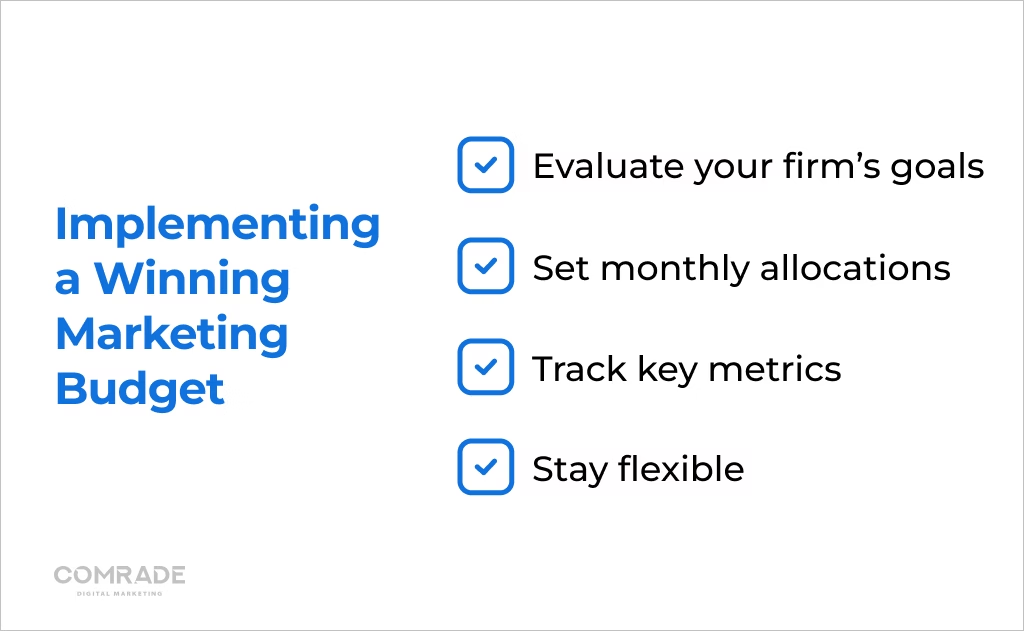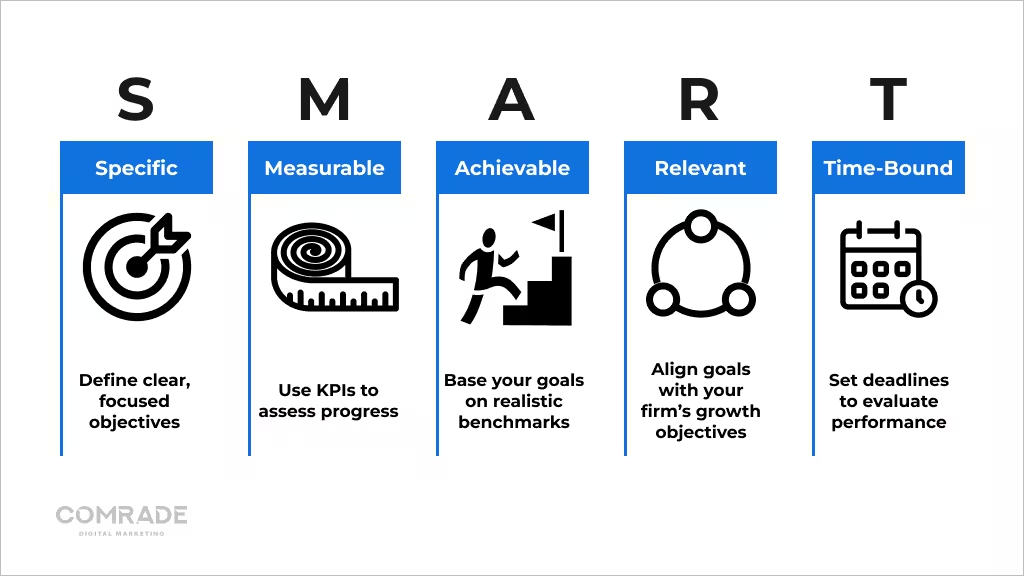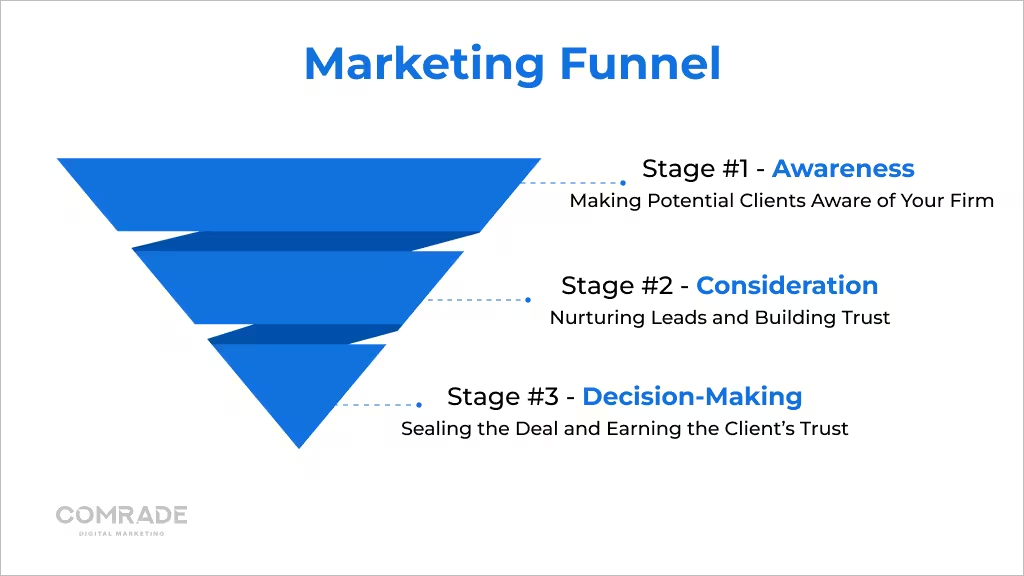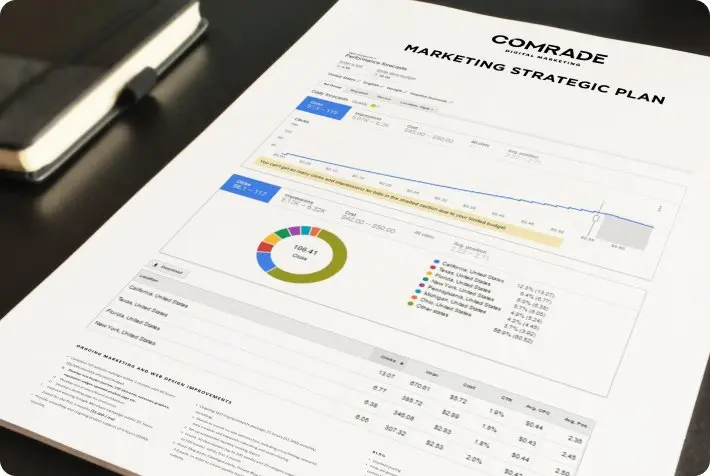The most successful law firms don’t rely on luck or guesswork.
— Do you have a clear lawyer marketing plan that tells you where to spend, what to track, and how to win clients?
If not, you’re likely wasting money, missing opportunities, and watching competitors dominate Google while you wonder why referrals are slowing down.
— Why do some firms grow consistently while others stagnate?
Because they treat marketing like a system — not a gamble. They work from a law firm marketing plan that sets a roadmap, defines budgets, and measures results.
— Does this really matter for your practice?
Yes. Without a plan, law firms fall into one of two traps: spending too little and getting no traction, or throwing money at random campaigns that never pay off. A structured marketing plan avoids both.
In this guide, we’ll walk through practical steps, real-world law firm marketing plan examples, and the exact elements you need to compete in today’s legal landscape.

What’s the difference between a law firm marketing strategy and a law firm marketing plan?
Many lawyers use the terms interchangeably, but they serve different purposes:
- Marketing strategy is your big-picture vision. It defines where you want to go — your target market, positioning, and long-term goals.
- Marketing plan is the action map. It breaks that vision into specific steps — campaigns, budgets, channels, and metrics you’ll use to get there.
Think of your strategy as the destination and your plan as the GPS. Both matter, but without the map, you’ll get lost.
Find the top law firm marketing consultant transforming the legal landscape. Learn more now!
Comrade Digital Marketing Agency can help you with the above if you’re unsure how to go about it. Schedule a free consultation.
How do you set the right budget for a lawyer marketing plan?
A law firm marketing plan is only as good as the resources behind it. Setting a realistic budget is one of the hardest — and most important — steps.
Here’s a breakdown based on firm size and competitiveness:
- Solo practitioners / small firms ($2,500 – $5,000 per month):
Focus on local SEO, Google Business Profile optimization, and consistent blogging. These deliver compounding results without requiring massive spend. - Mid-sized firms ($5,000 – $10,000 per month):
Add targeted Google Ads and email marketing to your mix. This balance captures immediate leads while nurturing long-term growth. - Large or multi-location firms ($10,000+ per month):
Invest in full-channel dominance — advanced PPC, video marketing, remarketing campaigns, and professional branding to stand out in crowded urban markets.
The key isn’t just how much you spend, but how consistently you commit. Sporadic bursts don’t work. A winning lawyer marketing plan allocates steady resources across the year, then fine-tunes based on performance data.
How can you implement a winning marketing budget?
Building a budget isn’t about cutting checks — it’s about discipline and follow-through. Here’s a framework you can apply immediately:

- Evaluate your firm’s goals. Are you chasing local dominance, expanding into new practice areas, or aiming for higher-value cases?
- Set monthly allocations. Break your yearly number into manageable monthly goals, then adjust based on performance.
- Track key metrics. Focus on cost per lead (CPL), conversion rates, and client acquisition costs to see what’s really paying off.
- Stay flexible. Shift dollars toward the channels producing the best ROI, rather than being locked into a rigid plan.
A strong law firm marketing plan treats the budget as a tool, not a burden. It’s less about “how much can I afford to spend” and more about “how much can I afford to grow.”
Need more leads? Find out how much should a law firm spend on marketing to fuel real growth!
What should a sample law firm marketing plan include?
A polished law firm marketing plan is more than a theory document — it’s a playbook. Here’s a step-by-step outline you can adapt immediately.
1. Define your objectives
Decide exactly what success looks like. Do you want:
- 30% more leads from your website?
- To dominate search results in your city?
- To expand into employment or family law?
Be specific. A law firm marketing plan examples document should clearly show measurable goals, not vague intentions.
2. Identify your target audience
Break down who you want to reach (employees, small business owners, injury victims, families going through divorce, etc.) and what their pain points are. Use demographics, behavior, and intent to sharpen your focus.
3. Choose your marketing channels
Select the channels most likely to connect with your audience. For small firms, that often means SEO and local search. For larger firms, paid ads, video, and remarketing may be essential.
4. Set your budget and timeline
Establish a 12-month budget, then divide into monthly allocations. Track results quarterly and adjust as needed.
5. Build campaigns and content
Decide what campaigns you’ll run — blog posts, paid ads, email series, video explainers — and map them against your budget.
6. Assign responsibilities
If you’re working with a marketing agency, define who owns which deliverables. If you’re keeping some work in-house, assign clear accountability.
7. Track, measure, refine
The best lawyer marketing plans evolve. Commit to regular reporting on cost per lead, conversion rates, and ROI. Adjust strategy when something underperforms.
How do you measure ROI with SMART goals?
An effective plan means nothing if you can’t measure results. That’s where SMART goals come in:

- Specific – “Increase website inquiries by 20% within 6 months.”
- Measurable – Use KPIs like leads generated, cost-per-lead, and conversions.
- Achievable – Base targets on industry benchmarks or past performance.
- Relevant – Goals should align with firm growth (e.g., targeting higher-value cases).
- Time-bound – Each goal should have a clear deadline.
Tracking against SMART goals ensures your marketing stays on course. Without them, even the best sample law firm marketing plan will lose direction.

Who is your target audience and how do you segment them?
One of the biggest mistakes law firms make is treating all prospects the same. A strong law firm marketing plan defines and segments your audience.
Consider:
- Demographics – Age, income, profession, geography.
- Behavior – What they search for, how they interact with your site.
- Intent – Someone Googling “employment lawyer free consultation” is closer to hiring than someone searching “workplace rights overview.”
By building personas — fictional profiles of your ideal clients — you can shape messaging that resonates directly with their pain points.
Ready to grow your practice? Dominate search results by partnering with a law firm marketing agency for SEO expertise.
What marketing channels belong in your law firm marketing plan?
The strongest plans use a mix of organic and paid channels. Key options include:
- SEO – Foundation for long-term growth. Optimized pages, blogs, and backlinks drive compounding traffic.
- Local SEO – Crucial for small and mid-size firms. Optimizing your Google Business Profile and collecting reviews helps dominate maps results.
- PPC advertising – Immediate visibility via Google Ads or Local Service Ads. Target high-intent keywords for maximum ROI.
- Website optimization – A fast, mobile-friendly site with clear CTAs is the hub of all campaigns.
- Email marketing – Keep past clients engaged and nurture new leads with valuable insights.
- Social media – Build awareness and credibility on LinkedIn, Facebook, Instagram, or even TikTok depending on your audience.
- Video marketing – Humanize your firm and explain complex legal topics simply.
Each channel should align with your budget and goals — not every tool belongs in every plan.
How does a marketing funnel turn leads into clients?
Your law firm marketing plan should map the client journey through three stages:

- Awareness – Prospects first discover your firm. SEO, PPC, and social media get them in the door.
- Consideration – They compare you with competitors. Email campaigns, blog posts, and testimonials build trust.
- Decision – They’re ready to hire. Clear CTAs, free consultations, and remarketing ads help close the deal.
A lawyer marketing plan without a funnel is like fishing without a net — you’ll attract prospects but lose them before they convert.
Discover the power of SEO for lawyers and unlock your website’s full potential.
Final Action Steps: How Do You Put Your Law Firm Marketing Plan Into Play?
To recap, here’s what you need to do:
- Set specific, measurable goals for your firm.
- Draft a sample law firm marketing plan with clear budgets and campaigns.
- Segment your audience and choose the best channels to reach them.
- Use a funnel approach to guide clients from awareness to decision.
- Track everything with SMART goals and ROI metrics.
- Refine regularly to stay ahead of competitors.
The firms that win aren’t the ones spending the most — they’re the ones with a plan. With the right roadmap, even small practices can outcompete larger firms.
Are you ready to build your firm’s growth engine? Start with your own lawyer marketing plan today — or partner with experts who can deliver measurable results. Contact us today to schedule a consultation and start building your success!

